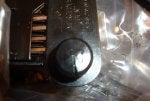Just as AMG proactively changed out his CPS after 180K miles I had the same philosophy and proactively changed out my Conductor Plate with 180K miles.
There were no codes and the tranny shifted smooth and perfect just a proactive measure incorporated into my routine maintenance of fluid and filter change and electrical connector bushing and the pressure regulator spring. Well actually I did also need to change that pesky PLIL seal.
Now for my question and your thoughts:
I noticed a crack in the outer plastic casing of one of the speed sensors that I first thought was simply a fatigue of the plastic surrounding the Hall Effect Sensor and was just glad I was proactively changing out the conductor plate.
However my photos looked similar to the photo in Figure 51 of ATSG Technical Service Information and stated:
"Inspect the Hall Effect Sensors for external damage. If internal damage to the transmission had occurred, such as 'planetary failure,' the sheet metal windows on the drums that excite the sensors can crash against the sensor tip, breaking its casing."
Could anyone lend some insight into the diagnosis of my conductor plate photos. Hopefully my first reaction of fatigue plastic outer cased was correct and I do not have any pending K2 bearing failure and planetary failure.
If MAVA, G-AMG or other knowledgeable members could weigh in on the photo assessment it would be appreciated.
Thanks.
Seth
There were no codes and the tranny shifted smooth and perfect just a proactive measure incorporated into my routine maintenance of fluid and filter change and electrical connector bushing and the pressure regulator spring. Well actually I did also need to change that pesky PLIL seal.
Now for my question and your thoughts:
I noticed a crack in the outer plastic casing of one of the speed sensors that I first thought was simply a fatigue of the plastic surrounding the Hall Effect Sensor and was just glad I was proactively changing out the conductor plate.
However my photos looked similar to the photo in Figure 51 of ATSG Technical Service Information and stated:
"Inspect the Hall Effect Sensors for external damage. If internal damage to the transmission had occurred, such as 'planetary failure,' the sheet metal windows on the drums that excite the sensors can crash against the sensor tip, breaking its casing."
Could anyone lend some insight into the diagnosis of my conductor plate photos. Hopefully my first reaction of fatigue plastic outer cased was correct and I do not have any pending K2 bearing failure and planetary failure.
If MAVA, G-AMG or other knowledgeable members could weigh in on the photo assessment it would be appreciated.
Thanks.
Seth










